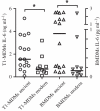Host-pathogen coevolution in human tuberculosis
- PMID: 22312052
- PMCID: PMC3267123
- DOI: 10.1098/rstb.2011.0316
Host-pathogen coevolution in human tuberculosis
Abstract
Tuberculosis (TB) is a disease of antiquity. Yet TB today still causes more adult deaths than any other single infectious disease. Recent studies show that contrary to the common view postulating an animal origin for TB, Mycobacterium tuberculosis complex (MTBC), the causative agent of TB, emerged as a human pathogen in Africa and colonized the world accompanying the Out-of-Africa migrations of modern humans. More recently, evolutionarily 'modern' lineages of MTBC expanded as a consequence of the global human population increase, and spread throughout the world following waves of exploration, trade and conquest. While epidemiological data suggest that the different phylogenetic lineages of MTBC might have adapted to different human populations, overall, the phylogenetically 'modern' MTBC lineages are more successful in terms of their geographical spread compared with the 'ancient' lineages. Interestingly, the global success of 'modern' MTBC correlates with a hypo-inflammatory phenotype in macrophages, possibly reflecting higher virulence, and a shorter latency in humans. Finally, various human genetic variants have been associated with different MTBC lineages, suggesting an interaction between human genetic diversity and MTBC variation. In summary, the biology and the epidemiology of human TB have been shaped by the long-standing association between MTBC and its human host.
Figures







References
-
- WHO 2010. Global tuberculosis control—surveillance, planning, financing. Geneva, Switzerland: WHO; (Contract No: WHO/HTM/TB/2008.393.)
-
- Barry C. E., 3rd, Boshoff H. I., Dartois V., Dick T., Ehrt S., Flynn J., Schnappinger D., Wilkinson R. J., Young D. 2009. The spectrum of latent tuberculosis: rethinking the biology and intervention strategies. Nat. Rev. Microbiol. 7, 845–85510.1038/nrmicro2236 (doi:10.1038/nrmicro2236) - DOI - DOI - PMC - PubMed
-
- Wilson L. G. 1990. The historical decline of tuberculosis in Europe and America: its causes and significance. J. Hist. Med. Allied Sci. 45, 366–39610.1093/jhmas/45.3.366 (doi:10.1093/jhmas/45.3.366) - DOI - DOI - PubMed
-
- Dye C., Williams B. G. 2010. The population dynamics and control of tuberculosis. Science 328, 856–86110.1126/science.1185449 (doi:10.1126/science.1185449) - DOI - DOI - PubMed
-
- Lonnroth K., Jaramillo E., Williams B. G., Dye C., Raviglione M. 2009. Drivers of tuberculosis epidemics: the role of risk factors and social determinants. Soc. Sci. Med. 68, 2240–224610.1016/j.socscimed.2009.03.041 (doi:10.1016/j.socscimed.2009.03.041) - DOI - DOI - PubMed
Publication types
MeSH terms
Grants and funding
LinkOut - more resources
Full Text Sources
Medical

